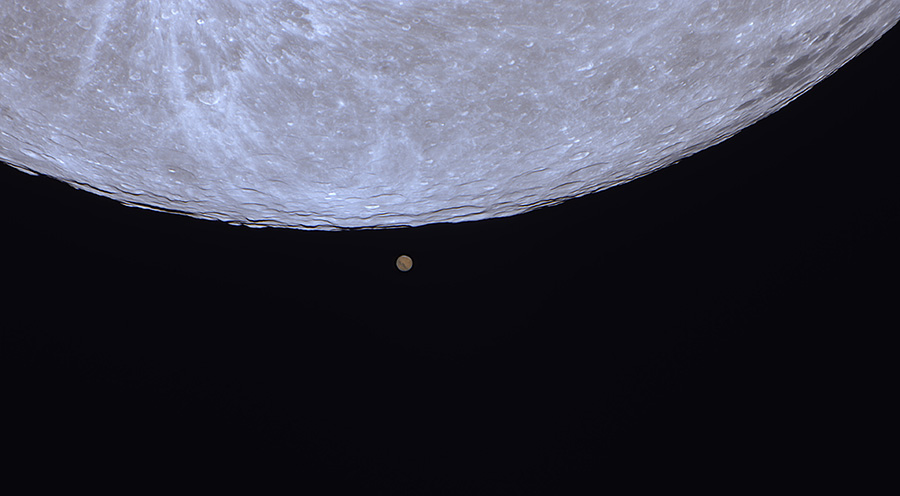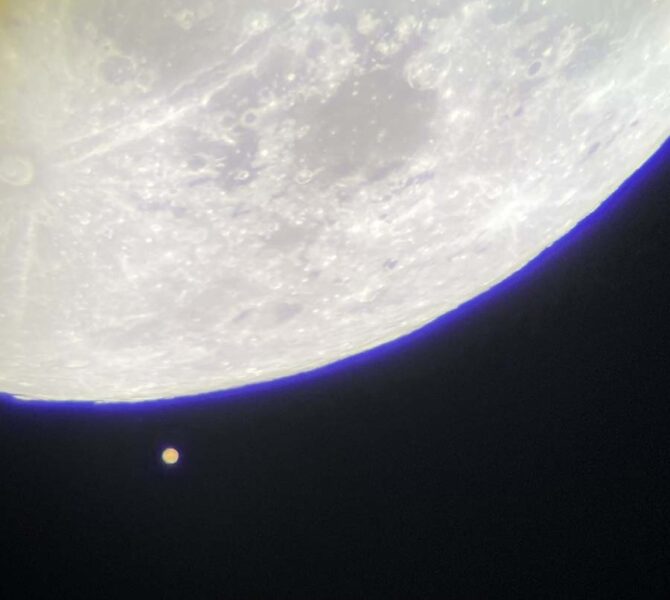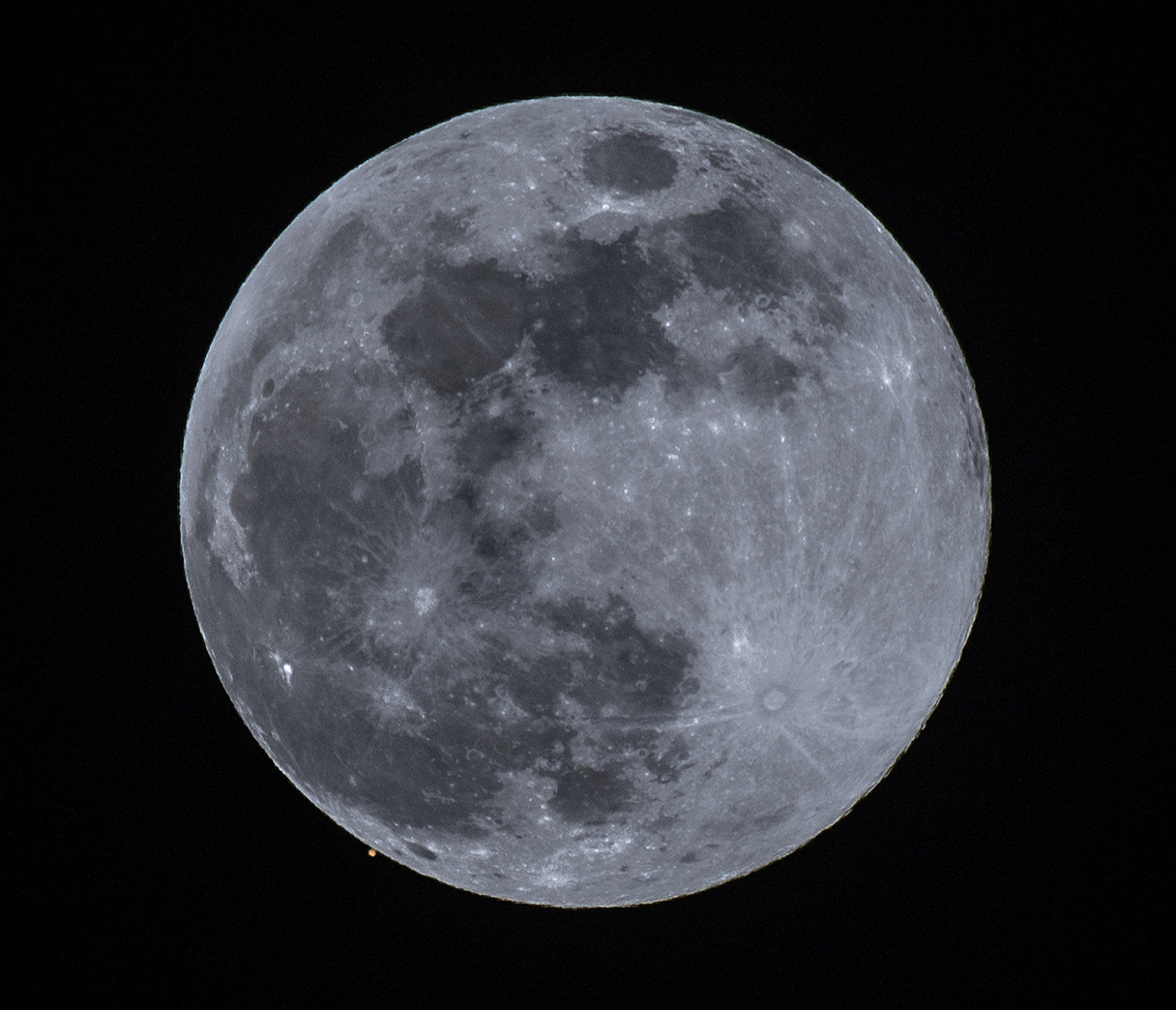Sky & Telescope editors report their observations of last night’s celestial event: Mars grazing or disappearing behind the Moon.

Sean Walker / Sky & Telescope
The occultation of Mars on December 7th was quite an event! Associate Editor Sean Walker watched the show from his home in Litchfield, New Hampshire, where it was a grazing (or partial) occultation, meaning Mars never completely went behind the Moon. "I was definitely at the right place to see an amazing partial occultation," he says.
Although the evening began cloudy with an unusually warm front adding low fog to the mix, the forecast was for clearing around 11 p.m. "I only had occasional glimpses of Mars as it approached the Moon and a brief peek at the ingress, and then nothing for several minutes. Finally, the skies began to clear about two-thirds of the way through the event." Walker watched as Mars slowly drifted along the southern limb of the Moon. (Those in the direct path of the event would have seen it take a minute or so to dive in directly.)
For several minutes, the Red Planet's tiny disk drifted behind crater rims with about a quarter to a third of the planet poking out above shadowed craters before gradually lifting away from the Moon's edge. "If you ask me," Walker says of the experience, "it was better than a direct occultation, because the partial occultation lasts several times as long as a direct occultation, and I could really savor the view. The craters had just enough shadowing to make the scene reminiscent of a Chesley Bonestell painting come to life."
Observing Editor Diana Hannikainen had checked the weather report earlier in the day and was disappointed to see little icons of rainy clouds throughout the evening hours. But, at a certain point, she happened to look out the window and was startled to see stars shining. Her first reaction was total panic — had she missed the event? Checking her watch she saw it was only 10:15 p.m. Mars was going to be close to the lower left edge of the Moon. Hannikainen sprung into action — she bundled her parents up (currently visiting from abroad), grabbed the closest scope to hand and a pair of binoculars, and headed outside.
Pointing her 4-inch refractor at the Moon, she saw "the impossibly perfectly round, orange disk of Mars hovering below the dazzling limb of the Moon," Hannikainen says, "a sight I’ll never forget." Nor will her parents; even though it was tough for them to access the eyepiece (the Moon was high! at around 70° altitude) they came back for multiple views. Over the next hour or so, they watched transfixed as the Moon glided above the Red Planet.
Although not armed with the same caliber of equipment as Walker, she nevertheless enjoyed the challenge of trying to snap shots of the view in the eyepiece with her iPhone 12 Mini. She succeeded (somewhat) in a couple of attempts, and keeps going back to those images, not quite believing that the skies cleared for the event (clouds scudded in at around 11:15 p.m.).

Diana Hannikainen / Sky & Telescope
From outside Boston, S&T Senior Editor Alan MacRobert watched the Moon make an extremely near miss of Mars in his 12.5-inch reflector. "At 300× the scene was like something from a science-fiction illustration," MacRobert says. "The huge, brilliant white limb of the Moon with its bumpy edge and the slightest bit of phase — thin lines of shadow from limb craters — next to this smallish, perfectly round disk of a bright orange planet."
The color contrast was striking, he notes. "I was surprised that Mars's surface brightness didn't look too much dimmer than the Moon's, compared to how they look in photos." Despite mediocre seeing he could could make out the Mare Cimmerium-Mare Tyrrhenum markings on Mars.
Mars skimmed to within ¼ of a Mars diameter (4 or 5 arcsecs) of the sunlit parts of the lunar limb. Wherever the dark limb actually was, it didn't extend far enough beyond to cause a partial occultation, as had been predicted, though MacRobert says, "I kept watching for it."
From Sky & Telescope's "western bureau," Consulting Editor Gary Seronik watched the occultation's ingress from Penticton, British Columbia, using a vintage Celestron 8-inch SCT and a 24mm Tele Vue Panoptic. The combination provided both magnification (83×) and a relatively large field of view.
"I viewed the occultation through a steady stream of fast-moving low cloud," Seronik says. "It was of course annoying that the sky was mainly clear except where the Moon was — a continuous conveyor belt of clouds passed through that area." But the clouds thinned at the crucial moments when the lunar disk covered the Red Planet. An hour later, when egress was due, the sky had completely clouded over. "Still," Seronik says, "given the weather, I felt really lucky to see what I did!"
S&T columnist Ken Hewitt-White reports seeing the occultation from his home in Chilliwack, British Columbia, also defying the weather odds.
"It was one of those nights that reminds us of why we got into the hobby in the first place," Seronik says. "It was also a cool demonstration of the 'dance of the planets' that goes on continuously, but is rarely noticed."
S&T readers have already submitted several images, including this Editor's Choice pick below:

Bill Hood / S&T Online Photo Gallery
See more photos here and share your own photos to Sky & Telescope's Online Photo Gallery!
 4
4









Comments
Rod
December 8, 2022 at 6:11 pm
Very nice Sky & Telescope, glad to see some images and folks who could see the celestial event.
You must be logged in to post a comment.
Michal
December 8, 2022 at 8:34 pm
Yeah, clouded over here as well. Thanks everyone for the vicarious experience via photos and reports.
You must be logged in to post a comment.
crk112
December 8, 2022 at 9:15 pm
In my 20+ years of reading S&T since I was a teen this is the first occultation I've observed myself. Perfectly clear skies from southwest of Minneapolis and just a dinky pair of binoculars... but enough to see Mars one moment, then gone the next! Happened pretty much as predicted, disappeared shortly after 9pm local and reappeared by 10:09pm. Great visibility and chilly, around 9F. Next time I'll get out the telescope. 🙂
You must be logged in to post a comment.
Anthony Barreiro
December 10, 2022 at 4:15 pm
The sky was clear around Mars and the Moon here in San Francisco. It was exciting to watch with just naked eye as the Moon got closer and closer to Mars, until the Moon's glare overwhelmed Mars about 10 minutes before the actual occultation. I observed the occultation itself with a 50 mm spotting scope at 22x magnification. Mars was a bright tiny orange disc, no detail. Both disappearance and reappearance took about a minute. It was nice to see a correct image through the spotting scope. And it was lovely and satisfying to watch the Moon move farther away from Mars for the rest of the evening.
I love the image of a Chesley Bonestell painting come to life.
You must be logged in to post a comment.
You must be logged in to post a comment.